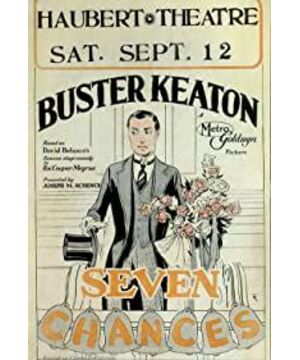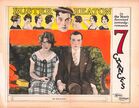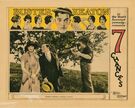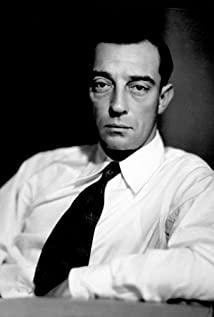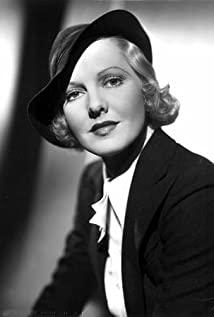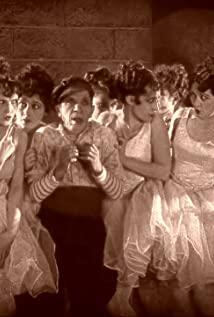Plot theme:
Businessman James Shannon (hereinafter referred to as Jim), in order to use his grandfather's huge fortune to get out of the economic crisis, must fulfill the only condition in his grandfather's will: to get married before seven o'clock in the evening when Jim is 27 years old.
Regarding how Buster Keaton expresses the plot theme:
"Seven Chances" is roughly divided into four paragraphs in structure, namely: Jim's unsuccessful confession to the girl he has long admired, Ruth Dwyer, Jim's financial crisis (this is the dramatic transformation of the film) The critical point, because he had financial problems, and at this time the lawyer just told him that his grandfather left a huge amount of property to Jim, but there are additional conditions), Jim tried his best to get married (this is the most interesting thing to see in the continued development of the story. The point part, which further deeply reflects the character conflict, psychological conflict, etc. in the story), Jim and Ruth Dwyer finally get married (this is the ending part of the film, the protagonist not only married the beloved woman, but also completed the grandfather's will. condition).
There are two main lines that make up the film:
one is the emotional main line formed by the businessman Jim played by Buster Keaton's love for Ruth Dwyer, or Jim and Ruth Dwyer's inner conscience, but because of their embarrassment. Emotional context that creates a mutual confession disorder.
The second is that Jim's grandfather left him a huge amount of property, which can help him get out of the economic crisis, but his grandfather gave Jim a problem in his will: to get married before 7 pm on the 27th.
The two clues intersect and interact in the second paragraph of the story, intensifying the contradiction and pushing the film to a climax.
The main scene at the beginning of the film is very monotonous: at the gate of the white fence in front of Ruth Dwyer's house, the film uses superimposed paintings to mark the four periods of spring, summer, autumn and winter, showing Jim and Ruth Dwyer chatting, flirting with each other, and tacitly understanding each other. A scene where you can't speak. This is also the first paragraph of the film, which mainly explains Jim's feelings for Ruth Dwyer. Ruth Dwyer's sometimes looking forward, sometimes excited, and sometimes lost expression tells us that Ruth Dwyer is also in love with Jim. But the first paragraph ended up being fruitless.
When Jim's business situation went wrong, the accompanying lawyer took out Jim's grandfather's will at this critical moment: as long as Jim can get married before 7 pm on the 27th, he is eligible to inherit the property. A dramatic picture was created - Jim looked at the date and time and found that there was only half a day left until 7:00 pm on the 27th. Immediately after, Jim mustered the courage to photograph Ruth Dwyer, wanting to express to her the feelings he had always buried in his heart, and the audience was also full of anticipation at this time. When Jim stands in front of Ruth Dwyer and proposes to her, there is a contradiction that leads to the third paragraph: Jim actually tells Ruth Dwyer that Jim can only get his grandfather's inheritance if she marries him before seven o'clock. Ruth Dwyer fell from her excitement to the bottom. She thought that Jim proposed to her for the sake of inheritance, so she rejected Jim with grief and disappointment. The film is gradually pushed to a climax.
In the third paragraph of the film, which is also the most exciting place, Jim's partner T. Roy Barnes and his lawyers proposed separately: to package Jim as a billionaire, and to publish marriage advertisements in local newspapers, as long as he meets the conditions and is willing to marry Jim. The women all assemble at the local church before seven o'clock; also let Jim find women at the club and propose on the spot. They have the same goal: to get Jim married before seven o'clock and get the money!
Due to the helplessness and the development of the form, Jim, who had a fierce inner struggle, complied with the proposal of his lawyer and his partner, and began to look for women in the club. He proposed to seven women abruptly, antics, the reaction of others in the club, and a series of factors. All further increased the drama of the film. In the end, none of the seven women agreed to Jim's request to marry, and Jim was treated as an alien because of this, so the motion of Jim's Club to find his wife officially failed. At this time, Ruth Dwyer was very distressed at home, and her expectations of Jim in her heart partially overcome her disappointment in him, so she called Jim's office. The careless operator took the wrong call at this time, and it was this mistake that Ruth Dwyer overheard a wonderful conversation between Jim and his partner: "I'd rather not have money than marry a woman I don't love, I just love Ruth Dwyer!" This call is the last step before the film's climax, and it is also the fuse of Ruth Dwyer's emotional change. She realizes that she has misunderstood Jim, so she can't wait to give the note that she wants to marry Jim to the slave Jules Cowles , asking him to quickly hand over the note to Jim.
The classic part of the climax of the third paragraph is presented to the audience at this time. Buster Keaton uses Griffith's parallel cross editing method to accelerate switching between different scenes at the same time, making the plot faster and faster, producing The huge time pressure not only aroused the emotions of the audience, but also fully reflected the dramatic effect of the plot theme in the development: Jim, who was dragged to the church by his partner, saw a huge crowd of women who came to marry (the exaggerated shape and the large number of people made it difficult for him to get married). Jim and the audience are amazed), only to get away with Jim, being chased by crazy women all over the road. However, Jules Cowles, the slave slave who is responsible for delivering the love note, has suffered many bumps on the road and lost the opportunity to deliver the note to Jim more than once. The clock in Ruth Dwyer's house drew nearer, and she waited anxiously for Jim's appearance.
At the end of the third paragraph, the film's two main lines merge, and we are unconsciously aware of the fact that Jim must get his inheritance, he must get married before seven, and he must marry the beloved Ruth Dwyer.
In the fourth paragraph, Jim's servants get rid of the women who are chasing him, and the priest and Ruth Dwyer prepare for their wedding at home. At this time there was an interlude, the clock in Ruth Dwyer's house was five minutes ahead, and the two lovers who thought they had missed the time were frustrated. But Buster Keaton got Jim and Ruth Dwyer married at the stroke of seven. The movie ends. And this last episode is like a breeze, making the gradually calm ripples roll gently again and spread to the surrounding.
The simple plot theme constitutes four classic paragraphs in the interlacing of the two main lines, in which a large number of character modeling, humorous plot arrangements (crazy women demolish walls and hold bricks to smash Jim, etc.), picture language (Jim is being In the process of chasing and killing, the boulders that fell down the mountain followed them on the "escape" road, etc.), which brought this plot theme into full play.
"Seven Chances" is a classic silent film. In just 50 minutes, nearly a century has passed since the film was released, but it still makes the audience laugh, nervous, excited, worried, joyful, and happy without a single line of dialogue. To continue the joy that Buster Keaton brought us. This is a well-deserved classic of the silent film era.
View more about Seven Chances reviews


